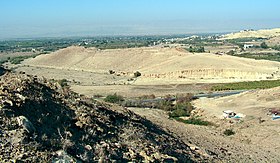Bethharan
Bethharan, Betharan or Beth Haran (for Hebrew: בית הרן), also Betharam or Beth-Aram (for Hebrew בית הרם; No linguistic relation to Aram), was a Hebrew Bible city, in the valley-plain east of the Jordan River. In the Book of Joshua, a city called "Betharam" is listed as one of the cities allotted by Moses to Gad,[1] previously belonging to Sihon the Amorite. According to the Book of Numbers, "Betharan" was rebuilt by the tribe of Gad.[2]

Later, it is called בית רמתה, (Ancient Greek: Βηθαραμφθᾶ - Betharamatha).[3][4] In the 1st century AD it was later fortified by Herod Antipas, the tetrarch of Galilee and Perea, who named it Livias in honor of Livia, the wife of the Roman emperor Augustus. As she was later called Julia, the 1st-century Jewish historian Josephus speaks of the city as Julias. Having been burnt at the fall of Jerusalem in AD 70, it was restored by the Christians and became a bishopric. The site is identified by some with Tell er-Rameh, six miles east of the Jordan, by others with Beit Harran.[5] Others identify it with Tall el-Hammam (Livias)[6]
See also
References
- Joshua 13:27
- Numbers 32:36
-

- Josephus, Antiquities 18.2.1. (18.26); ibid. The Jewish War 2.4.2. (2.57); Jerusalem Talmud (Shevi'it 9:2)
- Corbett, John (1913). . In Herbermann, Charles (ed.). Catholic Encyclopedia. New York: Robert Appleton Company.
- Graves, David E.; Stripling, Scott (2011). "Re-Examination of the Location for the Ancient City of Livias". Levant. 43 (2): 178–200.